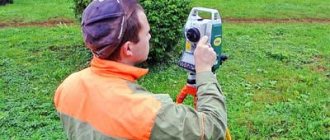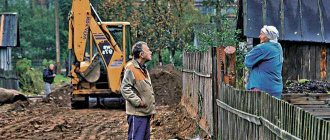One of the important stages of the site surveying procedure is the moment of approval of the survey project prepared by the cadastral engineer.
If it is necessary to perform such an action, directly interested in how the established boundaries will be drawn are notified in advance
The role of such persons is the owners or users of adjacent plots .
This is due to the fact that incorrect drawing of boundaries can infringe on their interests by affecting their immediate property.
In some cases, coordination with neighbors for certain reasons becomes impossible - in such cases, the question arises about the legal validity of the drawn up boundary plan and how it is possible to survey a land plot without coordination with neighbors.
When a neighbor may not sign a land survey agreement
Let us examine in more detail whether it is always necessary to obtain the consent of neighbors when carrying out land surveying.
Depending on the situation and circumstances, the absence of a signature from the owner of an adjacent plot may be due to various reasons, including simply disagreement with the boundaries (that is, a neighbor came to the meeting, but does not want to sign) or the absence of a neighbor in the process of direct approval borders.
Error while defining boundaries
If in the process of carrying out calculations and subsequent placing the boundaries of the site on the ground, the cadastral engineer makes a mistake , it is quite possible that the passing boundary will not suit the neighbor, since it encroaches on part of his property.
In such situations, the owner of an adjacent plot has every right to refuse to sign and demand that inaccuracies be eliminated first, which can also be additionally reflected in the boundary plan.
Subsequently, if it turns out that there was in fact no error by the engineer, the owners of the site may have to resolve such an issue in court if they cannot come to a common opinion peacefully.
Long absence
A peculiarity of holding a meeting at which an agreement on establishing the boundaries of a land plot is signed is that information about this must be carried out within the period strictly specified by law - no later than 1 month before the meeting is held .
This provision was adopted so that plot owners could plan their time in advance to be personally present and sign as a sign of consent.
Despite this, in some cases, neighbors, even having received notification on time, do not have the opportunity to appear, since they are undergoing long-term treatment in a medical institution (sanatorium, etc.) or are in a remote place due to work issues related to the specifics of their work activity .
In such situations, the absence of such a person does not always become the reason for the impossibility of drawing up a boundary plan without his signature - in the absence of a statement of disagreement with the plan, the document drawn up may well have legal force .
The owner's heirs did not have time to enter into property rights
In some cases, situations may arise that at a certain point in time, when the boundaries of a plot are being determined, the adjacent land plot actually does not have an owner .
Such situations may occur if the direct owner of the plot has died and his potential heirs have not yet assumed their rights - 6 months have not elapsed from the date of death, or there is a property dispute.
In such a situation, since ownership has not been established, the heirs do not have the right to sign such an agreement .
Demarcation scheme
The boundary diagram is a visual image of the area between the plots on the cadastral plan, which shows all adjacent plots. The diagram shows the numbers of all adjacent plots and their area.
The implementation of the scheme is carried out by a special organization that has the right to carry out this type of work during land surveying on the basis of the following primary documents:
- materials for territorial planning and development;
- land management materials;
- red lines;
- territory planning documents;
- materials about protected and special areas;
- availability of public areas.
When preparing the scheme, all future construction projects under state, federal or regional programs must be taken into account. Including unfinished construction projects.
You can read more about the boundary scheme in this article.
When can land surveying be done without the consent of neighbors?
When carrying out the procedure for approving boundaries in certain situations, on the basis of the Land Code of the Russian Federation and the Federal Law “On the Cadastre”, situations are identified when the absence of a signature of the owner of an adjacent plot does not become an obstacle to drawing up a boundary plan.
Let's consider in what cases land surveying without the presence of neighbors is acceptable.
No-show
In the event that the previously notified owner of the adjacent plot did not wish to appear at the approval procedure, and did not send his legal representative to attend or did not respond to the received notice with approval or refusal, his absence during such a procedure is automatically accepted as consent .
In such situations, it is necessary to clearly notify interested parties - only if there is strong evidence that notification took place, it will be almost impossible to challenge the boundary plan.
If the information is unknown
Sometimes, in the process of preparing boundary plans, plot owners and engineers are faced with the problem of lack of information about the owner of a neighboring plot, or his location is unknown.
Such situations also have their own solution - notification is made by publishing an announcement about the upcoming meeting and thus the person is considered automatically notified.
In some situations, a neighbor who has not shown up may subsequently challenge the passing boundaries, but this is quite difficult to do , since the truth is on the side of the engineer who followed the procedure for carrying out the notification procedure established by law.
Established boundaries for adjacent areas
Often, land surveying takes place in situations where boundaries have already been established for all adjacent sections, that is, this actually means that the approval procedure has already taken place and although it was carried out in relation to other sections, this means that there are no contradictions between neighbors, and all of them confirmed their agreement with the way the borders are drawn.
If the engineer, when carrying out work on the site, does not find any inaccuracies or errors and the passing boundaries will exactly coincide with the passing boundaries of neighboring sections, in such a situation approval is not mandatory .
On the other hand, some experts still advise, if possible, to perform this action , thereby protecting yourself from possible litigation related to the need to change the boundary.
When and why were the standards for indentation from the boundaries of a land plot invented?
Information on how much to retreat from the fence, from the streets, from neighboring plots and erected buildings during the construction of a house is contained in urban planning and norms and regulations (SNIPs, SanPins), and is also enshrined in the law on fire safety. These norms were developed back in the last century for the safety of citizens, when private property did not yet exist. Over time, taking into account the development and development of territories, the norms and rules have changed along with other land legislation. There are sets of rules that regulate the construction of buildings within the city (SP 30-102-99). There are rules that provide for the development and planning of summer cottages (SP 53.13330.2019). Along with these codes, Sanitary Rules were adopted, which indicate the permissible minimum distances from gas pipelines, farms, wastewater treatment plants to individual buildings (SanPin 2.2.1/2.1.1.1200-03), as well as requirements for fire safety clearances (123-FZ dated July 22, 2008 g., as amended from April 30, 2021 No. 117-FZ, SP 4.13130.2013) Let's consider what rules and regulations for minimum setbacks from the boundaries of the site apply when building a house on dacha and garden plots in SNT.
Invalid survey without signature
In certain situations, the signature of neighbors is necessary in order for the boundary plan to still have legal force and the passing border of the land plot to be recognized as valid.
The cases where a boundary plan cannot be recognized as valid without a neighbor’s signature are as follows:
- The neighbor's attendance at the meeting. At the same time, he expresses his disagreement with the passing boundary and, as a consequence, the boundary plan cannot be considered valid without eliminating the reasons for such disagreement;
- The neighbor sent an official letter in which he informed about certain requirements regarding the boundaries (in fact, disagreement with the way the cadastral engineer sees the location of the boundaries). In such a situation, there should also be an elimination of inaccuracies, an attempt to still come to an agreement with a neighbor or, as a last resort, go to court to protect one’s rights;
- There were no procedures in place to properly notify stakeholders. That is, even if there was information about the neighbor’s location, a notification was not sent to him.
A similar situation also applies if the neighbor’s residential address is unknown and an announcement about the meeting has not been published in the local media.
In this case, the neighbor has the legal right to subsequently protest the results of the land survey and the court will most likely be on his side.
Disagreements with neighbors
The boundaries of the land plot are determined by measurements carried out by a cadastral engineer as part of the land surveying procedure, and are then fixed in the graphic part of the land survey plan.
Before legally consolidating the boundaries, they must be agreed upon with all interested parties, in accordance with paragraph 1 of Art. 39 of the Federal Law “On Cadastral Activities No. 221. Interested parties may be neighbors who use their plots on the following basis:
- Ownership;
- Lease contract;
- Right of unlimited use;
- Lifetime inheritable ownership.
Signatures of neighbors in the act of approval of boundaries (on the back of the boundary plan of the land plot), according to clause 2 of Art. 40 Federal Law No. 221, give the cadastral engineer grounds to consider the boundaries fully agreed upon and document them.
What to do if it is not possible to find the owners
If, during the preparation of the draft boundary plan, immediate neighbors could not be found, the owner of the site, in order to ensure that it is impossible to challenge the drawn up boundary plan, must strictly follow the requirements of legislative acts.
That is, in cases where the whereabouts of the neighbor are not known, it is necessary to comply with the existing procedure for notification in such cases - the original of the media in which the notification was published is attached to the boundary file as evidence of compliance with the required procedure .
Determination methods
Information about the site is reflected in a huge number of different documents : technical passport of the BTI, general plan, construction projects and boundaries of the site. Sometimes there are serious differences between them in defining boundaries.
The developer, when preparing documents for the construction of a new property or for the sale of an old one, must be guided by the correct option for marking boundaries.
According to the latest norms of land legislation, the most accurate coordinates are indicated in the State Real Estate Cadastre (GKN).
In order to make adjustments to all existing documents where the boundaries are incorrectly indicated, the owner must request GKN information by email through Rosreestr or by personally contacting the regional cadastral authority.
If Rosreestr does not have the necessary information about the boundaries of a particular land plot, a special mark is placed in the extract stating that the boundaries of such land plot have not been established.
In the case when the information stored in the Unified State Register contains the coordinates of the characteristic points of the State Land Register, which were established with the required standard accuracy for the corresponding groups of lands, additional clarification of the State Land Register is not required.
To determine boundaries, the owner can contact the “Public Cadastral Map” (PCC) service, which, based on the address or cadastral number, will provide the user with all the necessary information that is freely available.
Users who have decided to contact PKK (pkk.rosreestr.ru.) need to be careful, since this service has duplicate sites that can transmit false information.
You will find a detailed description of all methods for determining storage boundaries here.










